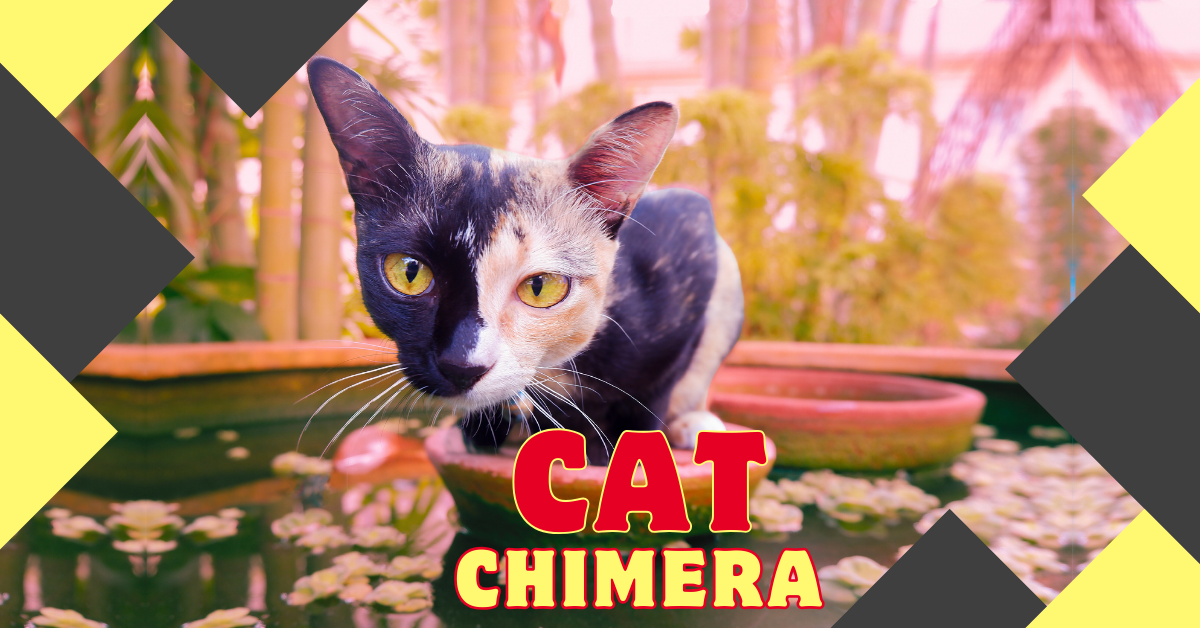Chimera cats are some of the most visually stunning and genetically unique animals in the feline world. These rare cats are often recognized for their dual-colored faces and distinctive coat patterns, which give them an almost mythical appearance. While these cats have become internet sensations due to their striking looks, there’s much more to them than meets the eye. In this article, we’ll explore 5 fascinating facts about chimera cats, the science behind this rare genetic phenomenon, and what makes these cats truly special.
What Is a Chimera Cat? Understanding the Science Behind This Rare Phenomenon
A chimera cat is not a specific breed but rather a cat with a rare genetic anomaly. The term “chimera” originates from Greek mythology, describing a creature made up of parts from different animals. In this case, the name refers to the merging of two different sets of DNA within one animal.
How Chimera Cats Are Formed
They are the result of two fused embryos that combine in the womb during the early stages of development. Essentially, these cats are the genetic fusion of two non-identical siblings, and as a result, they carry two distinct sets of DNA. This condition creates the split-color pattern seen in many chimera cats, particularly in their faces, where the difference in DNA expression can be most obvious.
While it’s a rare phenomenon, it doesn’t impact the health of the cat. These cats live normal, healthy lives, just like any other cat. They simply have a unique appearance due to their unusual genetic makeup.
Chimera Cat Traits: What Makes Them Stand Out
One of the most striking features of this cat is its two-tone face, where one side may be black or gray, and the other side orange, white, or any contrasting color. This phenomenon is the result of the cat having two sets of genetic information, which can create a clear distinction between the two sides of the face and body.
Physical Traits
Here are some common physical traits that make them instantly recognizable:
- Split Face Pattern: One of the most common and well-known traits of these cats is the split-face appearance, where the two sides of the face are dramatically different in color.
- Bicolored Eyes: Some of these cats may also have heterochromia, or two different-colored eyes, adding to their striking look.
- Mismatched Coat Patterns: Beyond the face, their bodies can also display varying colors and patterns, often making them look like a blend of two entirely different cats.
Not Every Cat with a Split Face Is a Chimera
IIt’s important to note that not every cat with a split-color face is a true chimera. Other cats, such as tortoiseshells and calicos, can exhibit similar color patterns, but they don’t have the genetic fusion that defines this rare phenomenon. DNA testing is the only way to determine if a cat is a true chimera.
Common Chimera Cat Breeds and Appearance
These cats can occur in any breed, but certain breeds are more likely to display the distinctive traits of a chimera. This is due to the common occurrence of mixed-breed cats that carry a wider genetic variety, which can increase the chances of the chimera anomaly.
1. Domestic Shorthair
The domestic shorthair is one of the most common cat breeds and frequently displays the chimera pattern. With their diverse genetic backgrounds, these cats can showcase a range of coat colors and patterns, making it more likely for a chimera trait to emerge.
2. Tortoiseshell and Calico Cats
While tortoiseshell and calico cats are often mistaken for chimeras due to their patchy coats, true chimeras are genetically different. However, some tortoiseshell cats may also carry chimera traits, resulting in an even more dramatic coat pattern.
3. Mixed Breed Cats
They are most commonly found in mixed-breed cats. The mixing of different genes increases the likelihood of a cat being born with two sets of DNA, leading to the chimera’s distinct look.
Are Chimera Cats Healthy? Understanding Their Health Needs
While these cats may look unique, the good news is that they are typically just as healthy as any other cat. The genetic anomaly that causes their appearance does not necessarily lead to any specific health issues.
No Specific Health Risks
Unlike some genetic conditions that affect a cat’s health, being a chimera is simply a matter of physical appearance. There are no known health problems that are directly linked to the chimera condition. However, since chimeras are usually mixed-breed cats, their health will depend on their overall genetic background rather than the chimera trait.
Regular Veterinary Care
As with any other cat, they require regular vet checkups, vaccinations, and preventive care. Chimera cats are no more susceptible to illness than any other cat, but ensuring they receive routine health care will help them live long, healthy lives.
How to Care for a Chimera Cat: Health and Well-being Tips
Taking care of a these cat is no different from caring for any other cat. They require proper nutrition, regular exercise, and lots of attention to stay healthy and happy. Here are some tips to keep your chimera cat in top condition.
1. Diet and Nutrition
Like all cats, they need a balanced diet rich in protein. Choose high-quality cat food that meets their dietary needs and ensures they get the proper nutrients. Consult your vet if you’re unsure about what food is best for your chimera cat’s age, breed, and activity level.
Curious about other unique foods your cat can safely enjoy? Learn more in Can Cats Eat Coconut? 7 Vital Facts Every Cat Owner Must Know, and discover if this tropical treat is safe for your feline friend!
2. Grooming
If your chimera cat has a short coat, grooming will be relatively simple. Weekly brushing will help reduce shedding and prevent hairballs. Long-haired cats, like any long-haired breed, require more frequent grooming to prevent matting and keep their coats healthy.
3. Exercise and Play
These cats are just as playful and curious as other cats. Provide them with plenty of toys and scratching posts to keep them entertained and active. Regular playtime is essential for their mental and physical well-being.
4. Regular Health Checkups
Routine veterinary care is important for monitoring your chimera cat’s health. Make sure to schedule regular vet visits for vaccinations, dental care, and overall checkups to ensure they’re in good health.
Chimera Cats vs. Other Unique Cats: How Do They Compare?
These cats aren’t the only cats that boast unique coat patterns. Other cats, like tortoiseshell and calico cats, are often mistaken for chimeras due to their multi-colored fur. So, what sets these cats apart from these other eye-catching felines?
Tortoiseshell Cats
Tortoiseshell cats are known for their black and orange mottled coats but do not have the genetic makeup of a chimera. Their patterns are the result of a different genetic mechanism called X-inactivation, which gives them their distinctive patches of color. While both tortoiseshell and these cats can have similar appearances, only DNA testing can determine if a cat is a true chimera.
Calico Cats
Calico cats also feature a mixture of orange, black, and white patches. Like tortoiseshells, their coat color is due to X-inactivation rather than genetic fusion. While calicos are stunning in their own right, they are not genetically chimeras.
What Makes Chimeras Special?
The key difference between chimera cats and these other types lies in their genetic composition. These cats have two distinct sets of DNA, which gives them their dual-colored faces and bodies. This genetic anomaly makes these cats even rarer than tortoiseshell or calico cats.
Famous Chimera Cats: Meet the Internet’s Most Beloved Felines
The internet has fallen in love with several chimera cats who have become famous for their unusual appearances. These cats have captivated audiences around the world with their stunning features and charming personalities.
1. Venus the Two-Faced Cat
Perhaps the most famous chimera cat of all time, Venus is known for her perfectly split face, with one side orange and the other side black. Her unique appearance has made her an internet sensation, and she has garnered millions of followers on social media.
2. Quimera
Another internet-famous chimera cat, Quimera, also boasts a split-colored face, with one side black and the other side orange. Quimera’s striking look and playful personality have made her a favorite among cat lovers worldwide.
3. Narnia
Narnia is a blue-eyed chimera cat with a dramatic contrast between his black and gray fur. He has gained attention for his regal appearance and striking facial features, further proving how captivating chimera cats can be.
Conclusion: Why Chimera Cats Are Truly One of a Kind
Chimera cats are a true wonder of nature, with their unique genetic makeup and stunning appearance setting them apart from other cats. While their split-colored faces and dual-toned coats make them instantly recognizable, it’s their rare genetic composition that makes them even more fascinating. Although caring for a chimera cat is much the same as caring for any other feline, their distinctive looks and intriguing backstory continue to capture the hearts of cat lovers everywhere. If you’re lucky enough to have a chimera cat in your life, you’ve got a truly one-of-a-kind companion!
FAQs
- What is a chimera cat?
A chimera cat is a cat with two distinct sets of DNA, caused by the fusion of two embryos in the womb. - Can any breed of cat be a chimera?
Yes, chimera cats can be found in any breed, although they are more common in mixed-breed cats. - Are chimera cats rare?
Yes, chimera cats are quite rare due to the unusual genetic fusion required to create this condition. - Do chimera cats have health problems?
Chimera cats are generally as healthy as any other cat and do not face specific health problems due to their genetic anomaly. - How can you tell if a cat is a true chimera?
The only way to definitively determine if a cat is a chimera is through DNA testing. - What makes chimera cats different from tortoiseshell or calico cats?
Chimera cats have two sets of DNA, while tortoiseshell and calico cats exhibit their coat patterns due to X-inactivation. - Do chimera cats have split-colored faces?
Many chimera cats do have split-colored faces, but this isn’t always the case. Some chimeras display their dual DNA in other areas of their bodies. - Are there famous chimera cats?
Yes, cats like Venus and Quimera have gained fame for their unique appearances. - How should I care for a chimera cat?
Caring for a chimera cat is the same as caring for any other cat: provide a balanced diet, regular vet checkups, and plenty of love. - Do chimera cats make good pets?
Absolutely! Chimera cats are just as affectionate and friendly as any other feline and make wonderful companions.

Joseph Bush is a seasoned writer and researcher with over 7 years of experience covering a wide range of general topics, from lifestyle and technology to business and current events. He is dedicated to producing fact-checked, reader-friendly content that informs, engages, and empowers readers.
Throughout his career, Joseph has followed strict editorial guidelines, relied on reputable sources, and ensured every article meets the highest standards of accuracy and clarity. His expertise spans multiple fields, allowing him to explain complex topics in a way that’s easy to understand.
Passionate about continuous learning, Joseph stays updated on industry trends and best practices to deliver trustworthy, well-rounded insights. Readers can rely on his work for its credibility, depth, and real-world relevance.




